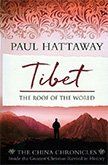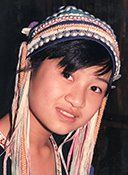1900s Tibetan Work
Kham ཁམས་
Further south in the Kham region of Sichuan and Yunnan provinces, the work of Catholic missionaries continued to advance, and by 1907 their flock numbered 2,050 believers (both Tibetan and Chinese), meeting in 14 churches. 1
A succession of French missionaries and their Tibetan converts were called to lay down their lives during the decade, including Henri Mussot and Jean-André Soulié, who were viciously murdered by Tibetan lamas at Batang in April 1905. The barbaric head lama had Mussot imprisoned in the monastery, where he was "tortured with spikes, and finally shot. His torturers cut off his head and displayed it like a trophy above the entrance of the monastery." 2
Eleven Tibetan Martyrs
The Tibetan Catholic church in Yanjing, where the Dalai Lama instigated a massacre in 1905. [Julian Hawken]
Many people around the world who are fascinated by Tibet are unaware that one corner of the vast territory has a rich Catholic heritage which survives to the present day. The small town of Yanjing, nestled just within the border of the present Tibet Autonomous Region, has long contained Catholic believers. The church was established there in 1865, after their community at Bonga had been pillaged and burned to the ground. The French missionaries "led their faithful followers to Yanjing and established themselves on a few bits of ground, thanks to the connivance of the local populace and the silence of the native chiefs." 3
By the start of the 20th century, this burgeoning group of more than 200 Tibetan Catholics did not go unnoticed by the leaders of Tibet. The Dalai Lama dispatched men from Lhasa to force the Christians to renounce their faith. The believers at Yanjing respectfully listened to the Dalai Lama's edict, but politely replied that they would not change, for they had found the one true religion. In response, the Dalai Lama's emissaries
"shot several Christian families in a field that is called the 'Field of Blood' to this day. Instead of intimidating the believers, this cruel act solidified their faith and caused them to permanently turn away from Buddhism. Yanjing has remained Catholic ever since, and by 1922 there were a reported 1,610 Tibetan converts in the area." 4
Another account of the persecution at Yanjing says:
"The lamas and their paid assassins pillaged and burned the mission at Yanjing. Since the stars were unfavorable that day, they were afraid to attack the living and so, like sinister hyenas, they dug up the missionary graveyard and threw the bones into the Mekong River.... Eleven Christians were bound to the pillars in the chapel. The next morning, April 18, 1905, they were dragged out into a field which from then on was to be called 'the field of murder.' They refused the offer to apostatize, and a hail of bullets cut them down. Their bodies were thrown into the river." 5
A Tibetan believer from Yanjing. [Julian Hawken]
On July 23, 1905, the French mission was struck by yet another outbreak of violence at Deqen in Yunnan Province, in the southernmost part of the Kham region. The heads of three martyrs, along with the heart and liver of 46-year-old Frenchman Pierre Bourdonnec, were carried like trophies to the large Deqen Monastery, where they were presented to the head lama. The depraved man, with a broad grin from ear to ear, commended the murderers for successfully completing their assignment.
Most of all, the head lama was overjoyed when he was presented with the head and organs of Jules Dubernard. For more than 40 years the Frenchman had loved the Tibetan people and was much more highly respected than the lama. The missionary had sacrificially served thousands of needy people without demanding anything in return, whereas the local monastery was known as a den of iniquity and the abode of lazy and corrupt lamas.
Dubernard's head was triumphantly hung on the monastery gate as a warning to the people not to follow Christ. The Church in this remote area suffered only a temporary setback, however. More workers soon came to replace those who had been martyred, and the local church survived and grew. By 1998 there were a reported 9,500 Tibetan Catholics in northern Yunnan and southern Tibet, in areas where Dubernard, Bourdonnec, and the other martyrs had laid down their lives. 6
Evangelical Progress
Three barefoot Tibetans who visited the CIM medical clinic at Dali.
The early 20th century saw an influx of many new Evangelical missionaries into the fringes of the Tibetan world, and a growing awareness arose that unreached Tibetans lived across a vast area of China. Even towns as distant as Dali and Lijiang in Yunnan Province were visited by hundreds of Tibetans during festivals and fairs, and the missionaries in those places eagerly shared the gospel by distributing Tibetan Scriptures. 7
The Evangelical enterprise in the Kham region showed signs of progress in the 1900s. Cecil Polhill reported from Batang:
"It will be remembered that when we left Kangding in 1900, there were no enquirers and the work was not particularly encouraging, but when our brothers went back two years later, after the Boxer troubles, and reopened the station, they found a great change in the state of affairs, so that in a few months' time 150 names of enquirers were enrolled....
The king of the Tibetans showed great friendliness and gave our brothers the use of his summer palace at Litang for their holiday. The inhabitants of the large monastery near this town had hitherto shown themselves to be bitterly hostile. This is all so changed that there is now a wide opening for work there." 8
In 1907, Edward Amundsen—a surviving member of Annie Taylor's failed mission—traveled extensively throughout the Kham region, sharing Christ with Tibetans wherever he went. The following excerpts from Amundsen's diary reveal both the tense spiritual atmosphere and the openness to the gospel at the time:
"In Kangding I went about and chatted with the friendly lay people and a few portions of Scripture were accepted as gifts! The lamas would not even speak with us. They are strictly looked after. The day I stayed there, no less than three monks were carried out dead, having been beaten to death for acts of immorality. Being told by the abbot to shun me, they would shun me; being told to befriend me, they would be friendly; being told to kill me, they would do so—of course all in the interest of religion." 9
"On May 10th I left Kangding again, for Litang, Batang and the west.... On the third day I reached my former Tibetan home at Golok. The people were delighted to see me after eight years absence. Seasoned and buttered tea and 'tsamba' were offered, as well as cheese and milk.... They gathered round my inn and chattered till late.... How readily these people would accept the gospel were there no lamas to forbid them! I left a number of Gospels with my host to be given away as he had opportunity." 10
"At Litang we had a great time distributing Gospels to the monks and others; in all 145. They were eager to get them. Not long ago they would ask foreigners to pass on at once and would scarcely allow them to stay a night even outside the monastery. Now I was able to go unhindered all through the great building which they say can accommodate 3,700 lamas. I do hope these books will work mightily among this great multitude of spiritual leaders!" 11
Footnotes:
1. Bertram Wolferstan, The Catholic Church in China (St. Louis, MO: Sands & Co.), 1909, p. 451.
2. My translation of the Henri Mussot Obituary in the Archives des Missions Etrangères de Paris.
3. Robert Loup, Martyr in Tibet: The Heroic Life and Death of Father Maurice Tornay, St Bernard Missionary to Tibet (New York: David McKay , 1956), p. 68.
4. Stauffer, The Christian Occupation of China, p. 282.
5. Loup, Martyr in Tibet, pp. 147-48.
6. See Alex Buchan, "Catholic Church Hangs on in Tibet," Compass Direct (September 1998).
7. For example, see W. T. Clark, "Gospel Work Amongst Tibetans," China's Millions (December 1909), p. 186.
8. Cecil Polhill, "Notes of the China Inland Mission Tibet Band," China's Millions (March 1905), p. 34.
9. Edward Amundsen, "The Diary of Journeys through East Tibet," Chinese Recorder (December 1907), p. 651.
10. Amundsen, "The Diary of Journeys through East Tibet," Chinese Recorder (December 1907), p. 653.
11. Amundsen, "The Diary of Journeys through East Tibet," Chinese Recorder (December 1907), p. 658.

© This article is an extract from Paul Hattaway's book 'Tibet: The Roof of the World'. You can order this or any of The China Chronicles books and e-books from our online bookstore.




